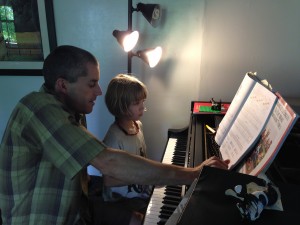Helping Kids Practice: Tips for Parents
- Marlene
- Blog, flute, Uncategorized
- 2 Comments
Helping Kids Practice: Tips for Parents
5 Ways You Can Help Your Child Practice and 4 Tricks To Try At Home
Neither of my parents were musicians. The only thing my dad ever said when I was practicing alone in my room was “Close your door! I can’t hear the TV over you.” Honest. I’m not making that up.
My dad, though he loved his TV, showed up for every single one of my music concerts. It must have made him crazy to listen to all that noise, but I always saw him in the audience clapping and grinning.Today I have two degrees in flute performance and make my living as a full-time musician. I have two kids of my own now and struggle with how to best support their practice.
As the parent of a musician, you’re giving your child an amazing gift by providing him with an instrument, books, music stand, lots of pencils (check out the blog post “The Pencil Problem”), and perhaps lessons. Give yourself a pat on the back. That’s more than many kids will ever get. It’s a huge family sacrifice to listen to the wrong notes, the squeaks, the high notes, the screams of frustration. And you’ve smiled through interminable school concerts and recitals.
But if you are like a lot of parents I know, you want to help your child. You know that she will enjoy the instrument more and have more success if she learns how to practice. I talk about how to motivate your child elsewhere on my blog (see the three posts on motivation, especially “Motivation: Parenting and Practicing”) but this post will focus on the ways parents can gently guide their musical children while practicing at home.
If you are able check in with your child’s practice for a few minutes two or three times a week, you will be helping your student tremendously. It’s not necessary that you be with your child for the entire practice time because it’s important that your child learns how to work independently.
- Open up your child’s ear. Young students have trouble listening to themselves. Remember, HEARING is different from LISTENING. (For more on this, please read the blog post “Hearing vs. Listening“) If your child isn’t paying attention to what’s wrong, he can’t fix it. When you are present in the practice room with your child, he will hear himself differently. You can also make an audio or video recording of your child playing his favorite piece of the week and listen to it together.
- Gently redirect wandering minds. If you notice that your child wants to talk to you as soon as she is finished with an exercise, the words rushing out almost before the last note is played, that’s a clear signal that her internal dialog is louder than the music. Listen to whatever she desperately needs to tell you but quickly redirect her attention back to the music. If she is having trouble focusing on the music, try some concentration exercises or brain games. (See a future blog post for more on this topic.)
- Mobilize resources. My son really enjoys watching YouTube videos of the pieces he is playing. The quality of the performers varies a lot, but even the bad ones give us something to talk about. Many good digital recordings are downloadable for a small fee on iTunes, Amazon, Google Play, etc. Ask the music teacher if there’s something your child should be focusing on for the week. Let the teacher know the difficulties you noticed during the week so the teacher can address these in the lesson. Reach out to musical friends or the internet when you are feeling stuck or frustrated.
- Help your child stay organized. Schedule practicing into your family routine. In our house, the children do half of their practicing in the morning before school and the other half before dinner. We try to keep this schedule consistent, even during the summer. Other families report that good times are right after dinner and first thing after school. Keep all the music books in one place so you don’t have to look all over the house when it’s time for the lesson.
- Make music a priority. In our house, when the choice is between baseball practice and a piano lesson, piano is always going to win. Ask your child about music class at school. Make sure your child knows that playing a musical instrument is a big part of his life now and into the future. You can even show them some of the incredible research that is being done on the cognitive and social benefits of music. A quick Google search will turn up many research studies or you can read about my favorites in blog posts “Better Brains,” “Brain Imaging,” “Music is the Key To Success,” and “Essential for Being Human.”
I want to give you some extra ideas about how to “open up your child’s ear.” Non-musician parents, don’t worry if your ear is “untrained.” A musical background is not necessary to help guide your child. You don’t need to fix the mistakes, just help your child recognize where there might be problems.
- Disturbances in the Force. When Obi Wan Kenobi and Yoda detect something is wrong in the Star Wars movies, they are unsettled by it. Wrong notes or rhythms have a similar effect. When you’re listening to your child play and something doesn’t feel right, it’s probably a wrong note or rhythm. When you hear something that makes your ear twitch, try saying one of the following:effect. When you’re listening to your child play and something doesn’t feel right, it’s probably a wrong note or rhythm. When you hear something that makes your ear twitch, try saying one of the following:
- “What was that?”
- “Hmmmmm….” “
- “Was that right?”
- “Can I hear that again?”
- “Check your notes.”
- The Game Show. If you have a young child, she may like this game. However, I have to warn you that this idea will not work for every child. My two kids enjoy it (we laugh a lot), but other students in my flute studio do not. Here’s how you play: Every time you hear something odd, make a loud beep or buzz, like the ones you hear for wrong answers on a game show. After the wrong note is corrected, you can have a different sound (like “whoo-hoo”) for praise. This works great if you’re making dinner and your child is in the other room practicing.
- Feel the Beat. Tap your toe or bop your head while your child is playing. If you’re having trouble keeping a steady beat, ie. instead of dancing you feel like you’re having a seizure, try one of the following:
- ask your child to tap her toe
- suggest using a metronome (tips in a future blog post)
- lightly tap on your child’s shoulder as she plays
- ask her to point out the rhythms that are hard and say “how would your teacher help you with these sections?
- Get Creative. If a passage is persistently difficult for your child, you may need to help her get out of a practice rut. Playing things again and again in the same way reinforces the mistakes. Try gently asking “What would it sound like if you played it slower / smoother / backward / …?” You can even be goofy with this. Perhaps you could ask her to play it “as fast as possible” or “jazzy.” The weirder, the wilder, the sillier, the better. The blog post “Practicing Upside Down” explains how turning the page upside down will create novelty and re-invigorate the brain. The post “Articulation Game” includes a game you can play with dice to change the articulations of a difficult passage.
Despite your best intentions, sometimes your ear will be wrong and your child will be playing the music correctly, but it doesn’t matter. Don’t be afraid of making mistakes. Your child will be quick to correct you and that’s OK too because you’ve just made her double-check her work, a useful skill in school as well as music. However, most of the time your ear will lead you in the right direction. Again, you don’t have to know how to fix the problem, but you can suggest resources to help your child and you can bring attention to a problem. You will enable her to look for ways to solve the problem and engage her ear on a deeper level.
Two final thoughts:
- Slow Down. There are very few children who enjoy practicing slowly, but brain research is confirming what teachers have been saying all along — slow practice with right notes is the most efficient use of time. You’re going to have to remind your child of this… a lot! Check out my blog post “Research on Effective Practice Skills.”)
- Practicing is Hard Work. Your kid will probably complain about how hard it is. You can help by offering perspective and encouragement. “Remember how hard the first piece in the book was? Now it’s easy for you.” When the going gets tough, seek out a teacher’s advice or scroll through my blog for more ideas on how to practice difficult sections, also known as “woodshedding.”
Your child is lucky to have a parent who cares enough to read this article. It is terrific that you sometimes listen to her practice. If you want to go the extra mile and give a helping hand, bravo! Don’t feel like you have to fix every mistake —your child needs to learn how to push through failures by herself too. When the shrieking, wailing, honking, ear-twitching notes become too much, you have my permission to turn on the TV and ask your daughter to close her door.


Its like you read my mind! You seem to know a lot about this, like you wrote the book in it or
something. I think that you could do with a few pics
to drive the message home a bit, but other than that, this is excellent blog.
A fantastic read. I will certainly be back.